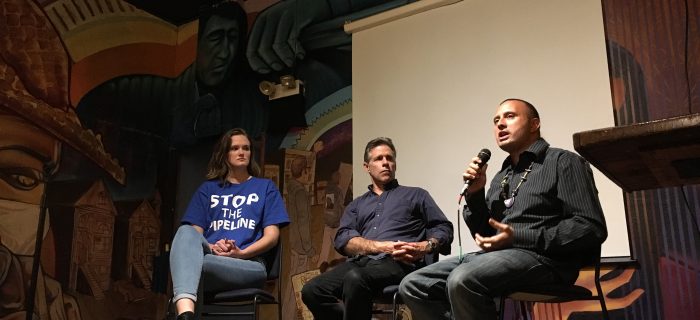Standing Rock and Iowa Pipeline Resistance: A Report-Back
Our ancestors have told us if the black snake comes across our land, our world will end.
-Iyuscan American Horse, Sicangu/Oglala Lakota
The subject of this prophecy takes form now as the Dakota Access Pipeline, also known as the Bakken Pipeline, a $3.8 billion project, is being shut down by water protectors.
If constructed, the pipeline would transport 570,000 barrels of fracked oil from the Bakken oilfields of North Dakota through South Dakota, Iowa, and Illinois — where it would then connect with existing rail and pipeline networks, ultimately arriving at refineries in the Gulf Coast. Crossing the Cannonball, Missouri, and Mississippi Rivers, among other major watersheds, leaks would contaminate thousands of tribal members’ drinking water — and millions more downstream.
Food First’s October panel event at La Peña Cultural Center in Berkeley, California hosted Hartman Deetz, Ahna Kruzic, and Todd Darling, who spoke about the resistance in Standing Rock, Iowa, and beyond.
Hartman, Mashpee Wampanoag, has visited Standing Rock in solidarity with the Sioux (Oceti Sakowin) peoples.
He began the evening’s discussion with a remark of awe:
Indigenous peoples from Ecuador, Chile, Canada, Finland, and supporters from all around are up there… its amazing to see so many people coming together around something so fundamental to all of us — water.
“The cowboy and Indian alliance isn’t new; it’s always been people against profit,” remarked Hartman, commenting that those profiting convince communities that they have less in common with each other than they do with those in power. “This has been the trick all along. Divide and conquer.”
“The more you strip things down, the more you have to look at the commonality between us. Differences disappear very fast. This project puts at risk our very future,” he said. “When you talk about threatening people’s water, it becomes very hard to break people apart.”
Stay in the loop with Food First!
Get our independent analysis, research, and other publications you care about to your inbox for free!
Sign up today!Ahna, a founding member of the Iowa-based Bakken Pipeline Resistance Coalition, a coalition of organizations representing landowners, community members, non-profits, and interest groups united to stop the construction of the Bakken (or Dakota Access) Pipeline, spoke of a similar coming together in #NoDAPL/ #NoBakken battle. Ahna spoke of a common narrative in Iowa that positions farmers and environmentalists as at odds; many in the conventional agricultural community assume that “environmentalists just don’t understand that agriculture as we know it is necessary for the economy.” However, as Ahna explained, this “farmer vs. environmentalist” narrative has, to a certain extent, slowly disintegrated under the common resistance against the Bakken Pipeline.
The struggle in Iowa was, at one time, popularly positioned as a protective movement for agricultural land. Ahna explained that oftentimes, landowners and community members dissented on behalf of Iowa’s industrial agricultural economy, “And you’d hear people say things such as…’we can’t put this pipeline in the ground…if we did that it would ruin our agricultural economy!’”
Over 2.5 years, Ahna explained that the discourse of dissent has shifted and broadened. “You hear it all now. We can’t put this in the ground because of future generations, because of our communities, because of our indigenous brothers and sisters in North Dakota and in Iowa and beyond. Because it will impact the Mississippi river, climate change….It will impact our entire world.”
What started for many as a battle over eminent domain and private property rights continues as a struggle for that and so much more — community, future generations, and allyship.
As colonial narratives disintegrate and mni wiconi (water is life) is normalized, industry increases their brutality, Hartman explained. We have all seen images of policemen dressed in full riot gear encroaching on peaceful prayer in North Dakota… dogs violently break the skin of indigenous peoples practicing their rights in peaceful protest to protect land that is theirs by treaty, helicopters intimidating protectors — the struggle continues, as Hartman emphasizes.
These fights aren’t new. Stealing of land is repetition.
The profit motive behind the Dakota Access pipeline is the same motive that continues to contaminate Flint’s water. It’s the same battle that dismantles farmers’ livelihoods around the world, ensuring farmers’ reliance on patented seed, chemicals, and capital. It’s the same struggle that locates noxious chemical production facilities in low-income communities of Color, and so on. But communities are coming together in powerful resistance.
In spite of the lack of media coverage that Todd Darling discusses, “…the grandmothers feel like they’re going to win,” he says.
They can build 11,071 miles but they can’t build 11,072, and its that last mile that counts.
All heads together, everybody is downstream.
Below is a video showcasing Hartman, Ahna, and Todd’s report-backs:
Video by Food First Fellow Leonor Hurtado.
Note: the map of the pipeline route in this video shows the route of the Keystone Pipeline.


 Help Food First to continue growing an informed, transformative, and flourishing food movement.
Help Food First to continue growing an informed, transformative, and flourishing food movement.




